How Zhukov defeated Army Group South on the Right Bank
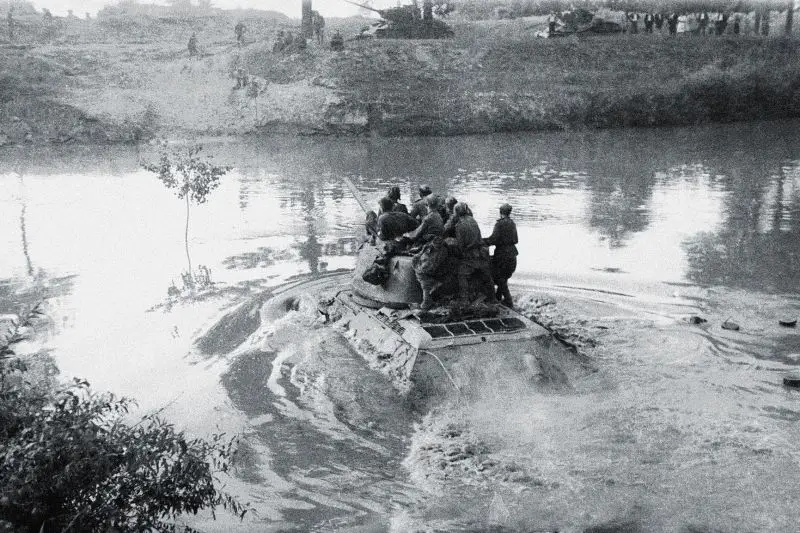
Crossing the Dniester River tanks T-34-85 of the 44th Guards Tank Brigade of the 11th Guards Tank Corps of the 1st Guards Tank Army
Operation Background
During the winter of 1944, during the offensive of the Red Army in Right Bank Ukraine, Soviet troops inflicted a serious defeat on the Germans near Zhitomir and Berdichev, Kirovograd, and defeated the Korsun-Shevchenko and Nikopol-Krivoy Rog groups (Fierce battle for Zhitomir and Berdichev; Defeat of the German 1st Tank and 8th Field Armies in the Battle of Korsun-Shevchenko; The assault on the Nikopol bridgehead and the defeat of the German 6th Army).
During the Rivne-Lutsk operation (January 27 – February 11, 1944), troops of the 1st Ukrainian Front liberated Rivne and Lutsk. As a result, Soviet troops captured the left wing of the German Army Group “South” from the north, and conditions were created for striking the flank of the enemy’s Proskurov-Chernivtsi grouping.
The 2nd Ukrainian Front occupied the initial area for the attack through Uman in the Mogilev-Podolsk direction. The 3rd Ukrainian Front reached the Krivoy Rog – Shirokoe – Kochkarovka line, gaining a chance to advance in the Tiraspol-Odessa direction. An opportunity arose to complete the liberation of the southwestern regions of the Ukrainian SSR and access to the state border of the USSR.
The headquarters of the Supreme High Command decided to launch several strikes almost simultaneously in order to split the German Army Group South into several separate groupings. For this purpose, four offensive operations were planned, which were named: Proskurovsko-Chernivtsi, Umansko-Botoshanskaya, Bereznegovato-Snigirevskaya and Odessa.
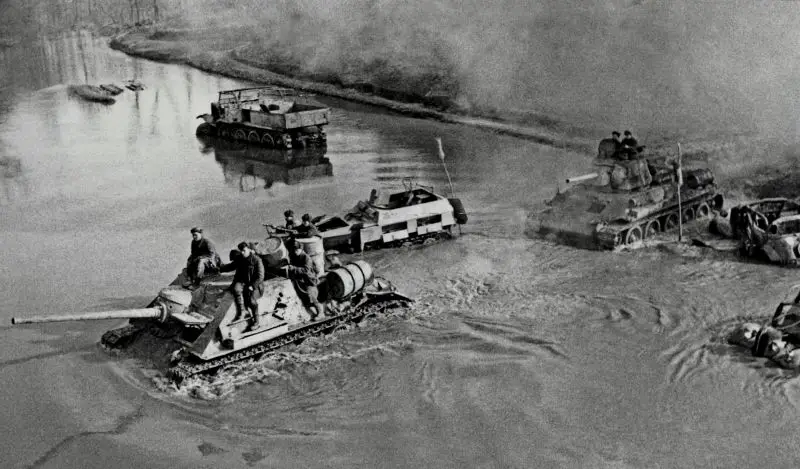
Soviet self-propelled guns SU-85 and a T-34 tank cross the Dniester near the city of Khotyn, Chernivtsi region, Ukrainian SSR. The photo shows German equipment: the Sd armored personnel carrier. Kfz. 250, half-track tractor Sd. Kfz. 9. April 1944
Operation plan and Soviet forces
The operation was to be carried out by troops of the 1st Ukrainian Front (1st UV), which, after the mortal wound of General Nikolai Fedorovich Vatutin, was led by Marshal Georgy Konstantinovich Zhukov. The 1st UV Front was supposed to launch an offensive from the line Dubno - Shepetovka - Lyubar. The front was given the task of defeating German troops in the area: Kremenets, Ternopil, Starokonstantinov. At the second stage of the operation, the 1st UV was supposed to develop an offensive in the direction of Chortkov and, in cooperation with the 40th Army of the 2nd Ukrainian Front, encircle and eliminate the main forces of the enemy’s 1st Tank Army.
The 1st UV included: the 13th Army under the command of General Pukhov, the 60th Army of Chernyakhovsky, the 1st Guards Army of Grechko, the 18th Army of Zhuravlev, the 38th Army of Moskalenko. The front had a powerful armored fist: the 4th Tank Army of Badanov (from March 29 headed by Lelyushenko), the 1st Tank Army of Katukov, the 3rd Guards Tank Army of Rybalko. The front was supported from the air by Krasovsky's 2nd Air Army. By the beginning of March, the front numbered about 800 thousand soldiers, 11,9 thousand guns and mortars, 1,4 thousand tanks and self-propelled guns and about 480 aircraft.
According to the plan of the Soviet command, the main blow was delivered by the 1st Guards, 60th Armies, 3rd Guards Tank and 4th Tank Armies. The strike group of the 1st UV was supposed to launch an offensive at the junction of the two German 4th and 1st tank armies, break through the enemy’s defensive formations and move in the general direction of Chortkiv.
Other armies carried out auxiliary attacks. On the left flank of the front: the 18th Army was advancing on Khmelnik, the 38th Army was attacking Vinnitsa and Zhmerinka, with part of its forces it was supposed to assist the 2nd Ukrainian Front in the liberation of the Gaysin region. On the right flank, the 13th Army ensured the advance of the front's main attack group from the north, conducting combat operations in the Brod direction.
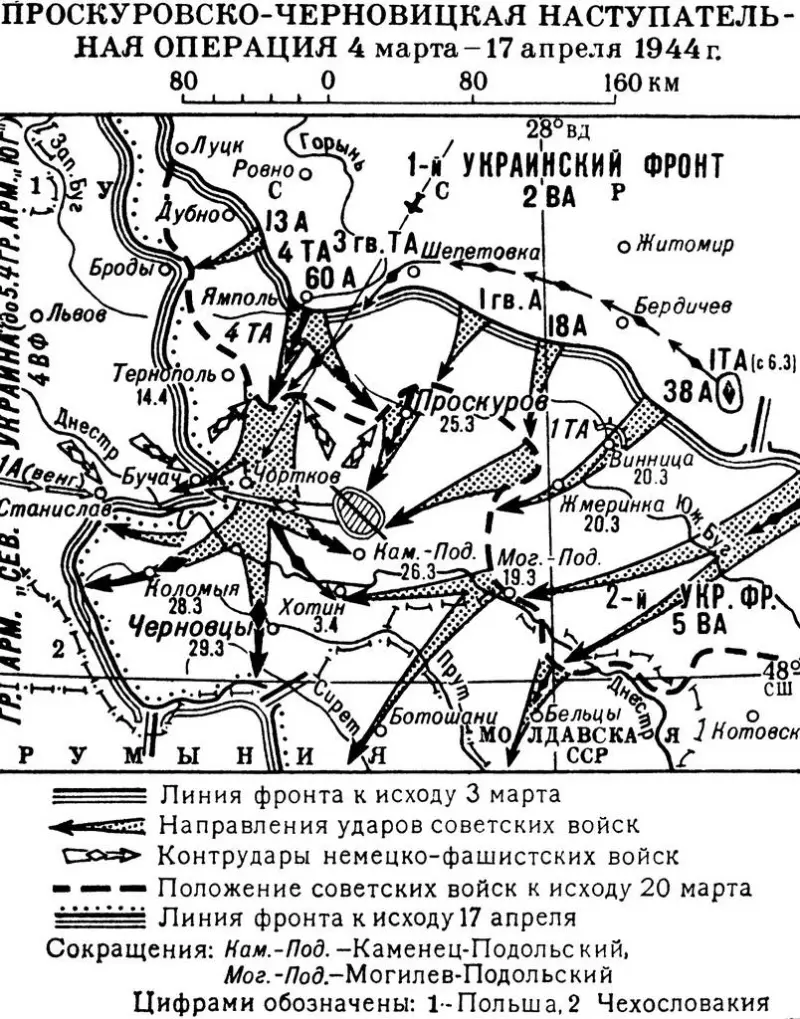
Before the start of the operation, the Soviet command had to carry out a significant regrouping of forces and means, since the most powerful forces were located on the left flank of the front, and they had to be transferred to the central direction. The 60th, 1st Guards Armies, 3rd Guards Tank Army, and a significant number of individual tank, artillery and engineering units were transferred to new zones and concentration areas. At the same time, many formations of the 18th and 38th armies changed their position. Katukov’s 1st Tank Army actually made a whole march to take its place in the shock formations of the main group.
The regrouping of troops was carried out in difficult off-road conditions and spring mud. The big problem was supplying the troops with everything they needed, especially fuel. Fuel supplies were insufficient, the troops could conduct active combat operations only for two to three days. However, Comfront Zhukov decided not to postpone the start of the offensive, since every day the muddy roads only increased and the German defense strengthened.
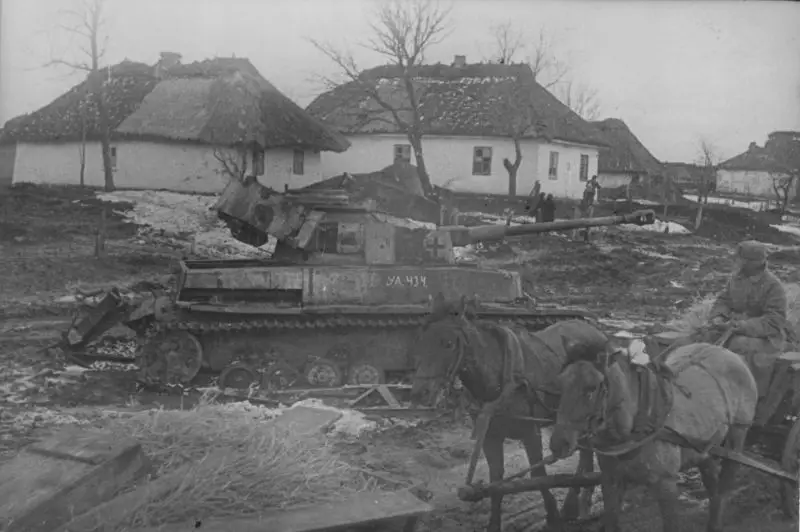
A Soviet soldier on a horse-drawn cart passes near a damaged German medium tank Pz. Kpfw. IV in a Ukrainian village near Proskurov. The tank is marked by a captured Soviet team: “UA 434.”
Germany
The Soviet troops were opposed by Army Group South, which from April 4 was transformed into the Northern Ukraine group, under the command of Field Marshal von Manstein (from March 31, headed by Walter Model). The Army Group included two German tank armies: the 4th Panzer Army under Erhard Routh and the 1st Panzer Army under Hans-Walentin Hube. From the air, the tank armies were supported by Otto Dessloch's 4th Air Fleet.
By the beginning of March, the German armies had 29 divisions (including seven tank and one motorized), a motorized brigade and a large number of other units and subunits. The German group consisted of about 500 thousand soldiers, about 1,1 thousand tanks and assault guns, about 5,5 thousand guns and mortars, 480 aircraft.
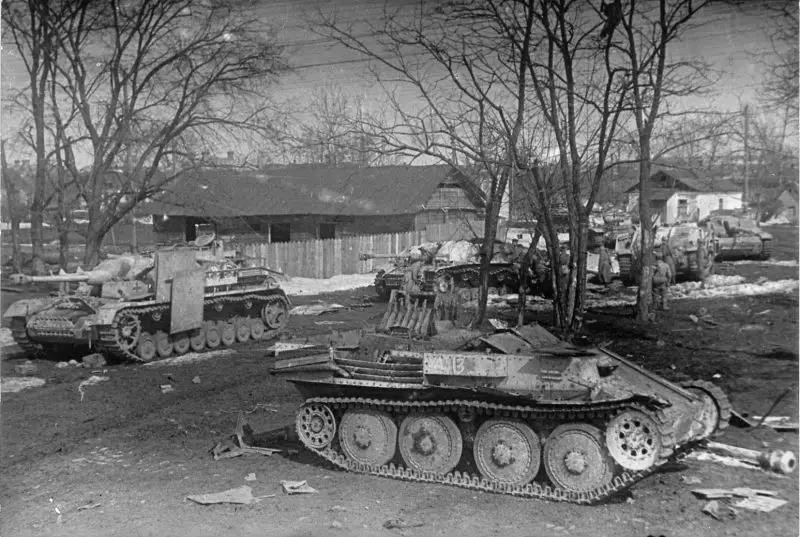
Equipment abandoned by the Germans in the city of Proskurov (now Khmelnitsky). In the foreground is a Marder III anti-tank self-propelled gun without a cabin and a gun (the gun lies behind the vehicle, its barrel is visible to the right of the self-propelled gun body). In the background are StuG IV and StuG III assault guns. March 1944
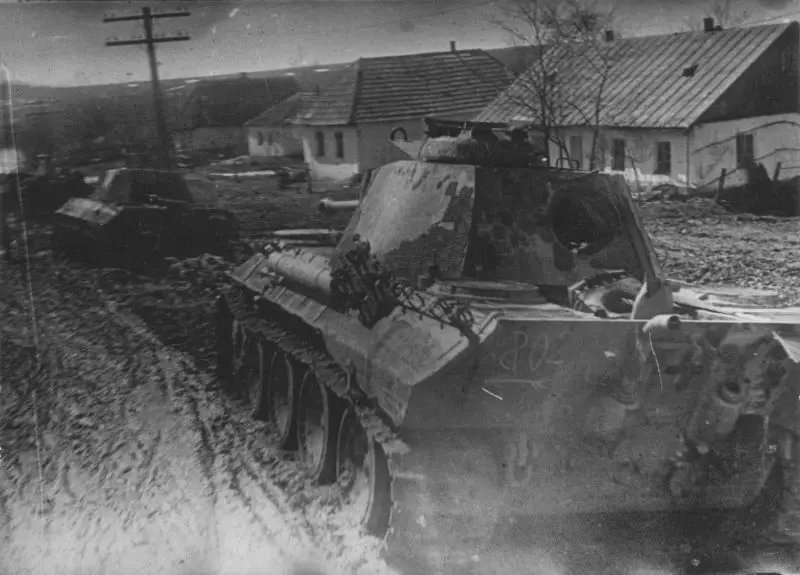
German tanks Pz. Kpfw. V "Panther", abandoned in Proskurov (now the city of Khmelnitsky). In the foreground is a Pz. Kpfw. V Ausf. A. April 1944
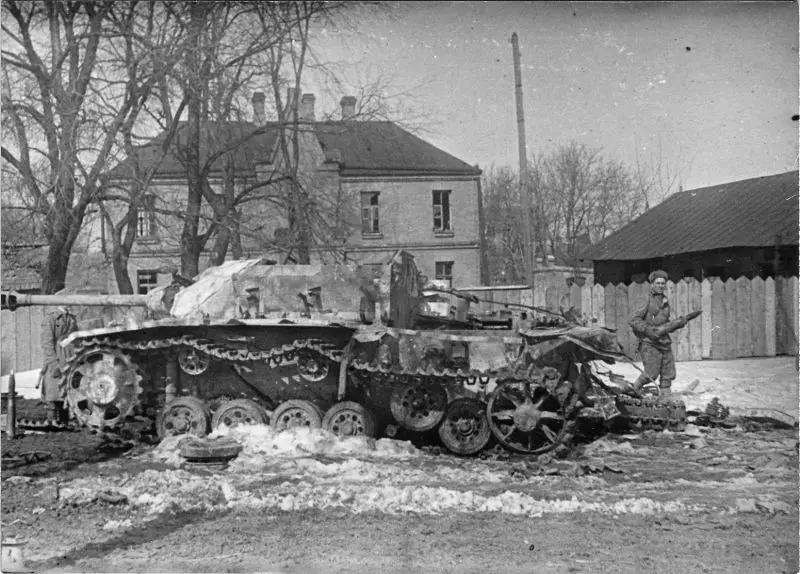
German self-propelled gun StuG III Ausf. G, abandoned in the city of Proskurov (now Khmelnitsky)
Defense breakthrough
On the morning of March 4, 1944, Soviet artillery struck enemy positions. Then units of Chernyakhovsky’s 60th Army and Grechko’s 1st Guards Army went on the offensive. Following them, the second echelon was brought into battle - Badanov's 4th Tank Army and Rybalko's 3rd Guards Tank Army. By evening, Soviet troops advanced 8–20 km.
On March 5, Zhuravlev's 18th Army went on the offensive. The Soviet armies broke through the German defenses in two days, creating a gap up to 180 km wide and penetrating to a depth of 25–50 km. On March 7–10, the advanced units of the Soviet armies reached the line Ternopil, Volochisk, Proskurov. The Lviv-Odessa railway, the main communication line of the entire southern wing of the Wehrmacht, was intercepted.
The German command began hastily transferring reserves to the breakthrough site. On March 9, units of the 60th Army and Pavel Poluboyarov’s 4th Guards Tank Corps attached to it encountered strong resistance from Nazi troops on the approaches to Ternopil. Here the defense was held by the 68th and 359th infantry divisions, which were transferred from Western Europe. Chernyakhovsky’s army had to fight heavy battles in the Volochisk area. Here the German command launched counterattacks with the help of the 7th Panzer Division and the SS Panzer Division Adolf Hitler.
Grechko's 1st Guards Army, with the support of Ivanov's 7th Guards Tank Corps from the 3rd Guards Tank Army, captured the Starokonstantinov area and reached Proskurov. Here the Germans deployed four tank divisions against the advancing Soviet troops: the 1st, 6th, 16th and 17th tank divisions.
The command of Army Group South threw large forces into battle: 9 tank and 6 infantry divisions. The Germans saw the main threat in the loss of control over the Lviv-Odessa railway. There was a threat of a break in the front and the dismemberment of Army Group South into two parts. The Germans counterattacked furiously, trying to stop the Soviet troops and regain control of the lost section of the railway.
In the current situation, the Soviet command decided to temporarily stop the offensive of the troops. It was necessary to repel the German counterattacks, regroup forces, tighten the rear, artillery, reserves, determine the direction of new strikes. The Supreme Headquarters agreed with the proposal of the Military Council of the 1 of the Ukrainian Front. 11 March 60-I and 1-I Guards armies were ordered to go on the defensive.
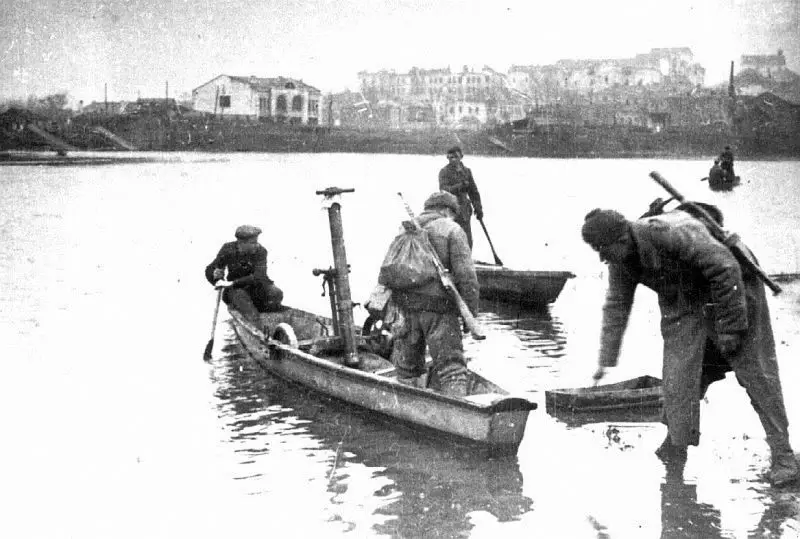
The crew of an 82-mm battalion mortar of the 1943 model (BM-43), with the assistance of local residents, is being transported across the Southern Bug River in the city of Vinnitsa in the Zamosc region. March 1944
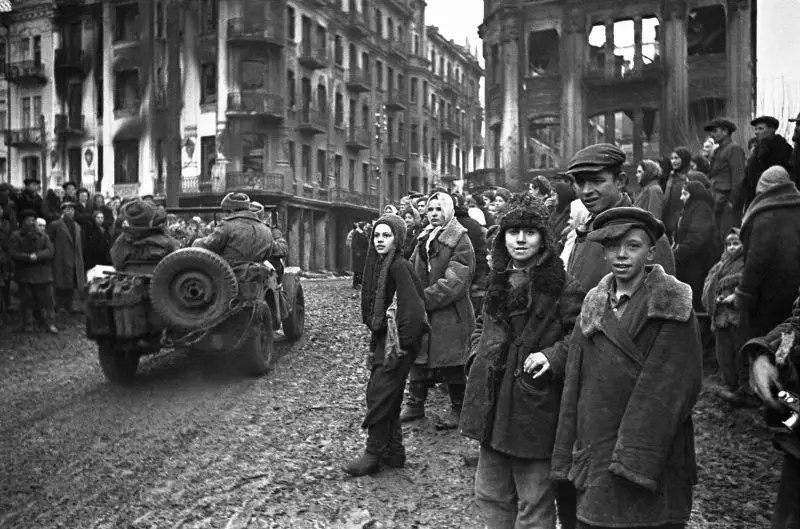
Residents of Vinnitsa meet Soviet soldiers-liberators. The city of Vinnitsa was under German occupation since July 21, 1941. It was liberated on March 20, 1944 by troops of the 38th Army of the 1st Ukrainian Front. When Soviet troops entered Vinnitsa fighting, the city was engulfed in fires set by the retreating Germans. Traces of fires are clearly visible in the photograph.
Offensive development
At the same time, Headquarters clarified the tasks of the 1st UV. The main strike group of the front was supposed to cross the Dniester and Prut on the move, liberate Chernivtsi and reach the Soviet state border. During this attack, the main formations of the 1st German Tank Army had to be isolated from the 4th Tank Army, cutting off its escape route to the south, beyond the Dniester. They planned to encircle and destroy the German tank army in the area northeast of Kamenets-Podolsky.
The right wing of the front (13th Army) was supposed to attack Brody and Lvov, providing assistance to the 2nd Belorussian Front, which was supposed to strike in the Kovel direction. The army's offensive was supported by the 25th Tank, 1st and 6th Guards Cavalry Corps. The left wing of the front (18th and 38th armies) advanced on Kamenets-Podolsky, providing assistance to the 2nd Ukrainian Front. The 40th Army of the 2nd Ukrainian Front was supposed to take part in the encirclement of enemy forces in the Kamenets-Podolsk region.
Pukhov's 13th Army, having broken through the strong enemy defenses, captured an important enemy stronghold - Dubno - by the end of March 17. Two days later, another serious enemy defense center was occupied - Kremenets. By March 20, Pukhov's army, having broken the resistance of seven German divisions, reached the approaches to Brody. This was where the army's successes ended. In the Brody area, the Germans created a strong defense and stubborn fighting took place here until the end of the operation.
By March 18, Zhuravlev's 38th Army and Moskalenko's 21th Army liberated Khmelnik, Vinnitsa, and Zhmerinka, pushing the opposing units of the 1st German Tank Army to Kamenets-Podolsky.
At this time, formations of the 60th and 1st Guards Armies, 3rd Guards and 4th Tank Armies repelled enemy counterattacks in the area of Ternopil, Volochisk and Proskurov. The battle was extremely fierce and stubborn. The Germans concentrated large forces here, including tank formations. The Soviet armies suffered heavy losses in manpower and equipment. So, on March 14, Zhukov reported to Headquarters that in Rybalko’s army only 63 tanks and self-propelled guns remained in service, in Poluboyarov’s corps (4th Guards Tank Corps) there were 20 tanks, and other armies also suffered heavy losses.
As Marshal Zhukov recalled:
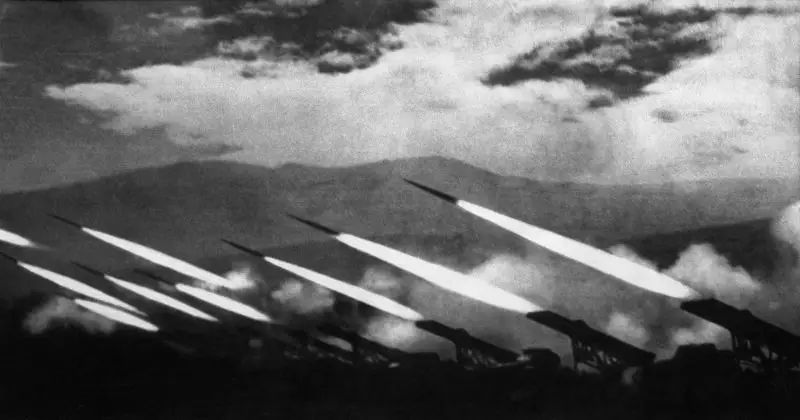
A salvo of Guards BM-13 Katyusha rocket launchers on the chassis of American Studebaker trucks. Western Ukraine. 1944
Through the Dniester and Prut
By the start of the new offensive, the front's strike force had been strengthened. Four rifle divisions were transferred from the front reserve to the 60th Army, and two divisions to the 1st Guards Army. Katukov's 1st Tank Army was transferred to the direction of the main attack. As a result, three tank armies were concentrated into one fist. On March 21, the main strike force again went on the offensive. The German defenses were broken through, and on March 23, units of the 60th and 1st Tank Armies recaptured an important communications hub - Chortkiv - from the enemy.
Formations of Katukov's tank army quickly advanced and on March 24 crossed the Dniester on the move. On the night of March 25, Colonel Boyko’s 64th Tank Brigade captured the Mosha station on the approaches to Chernivtsi, where the enemy train was unloading. On March 28, our tankers broke into the Chernivtsi airfield. On March 29, units of the 11th Guards Tank Corps under General Getman and the 24th Rifle Division crossed the Prut and liberated Chernivtsi.
Other armies also operated successfully.
The 4th Tank Army, having made a flanking maneuver, occupied Kamenets-Podolsky on March 26. Units of the 3rd Guards Tank Army and the 1st Guards Army recaptured Proskurov on March 25. Then the troops continued their attack on Kamenets-Podolsky from the northern direction. On March 28, the 3rd Guards Tank Army was withdrawn to reserve for replenishment. On March 31, units of the 4th Tank Army and the 30th Rifle Corps of the 1st Guards Army reached Khotin, where they established contact with formations of the 40th Army of the 2nd Ukrainian Front.
As a result, the 1st German Tank Army (23 divisions in total, including 10 tank divisions, about 220 thousand people) was blocked in the area northeast of Kamenets-Podolsk. The troops of the Soviet 18th and 38th armies were advancing from the east, the 3rd Guards and 4th Tank Armies from the north, and part of the formations of the 1st Guards Army from the west and southwest. The 4th and 1st Tank Armies made their way across the Dniester, cutting off the escape route to the south.
At the same time, the main forces of the 4th German Tank Army were thrown back to the west. In the Ternopil area, a small enemy group (12 thousand soldiers) was surrounded and continued to resist.

T-34 tanks of the 1st Ukrainian Front with armored soldiers crossing the Prut River.
Breakthrough from the pocket of the 1st German Army
German troops faced the threat of a major military disaster. However, the lack of forces at the front, the army had already suffered heavy losses in previous battles, did not allow the creation of a dense internal encirclement front.
Zhukov noted:
The Soviet command believed that the blocked Nazis would break through to the south through the Dniester in the Zaleschiki area. Therefore, Soviet troops intercepted the escape route to the south. The German command found out about this and ordered the encircled divisions to break through not to the south, but to the west through Buchach and Podgaitsy.
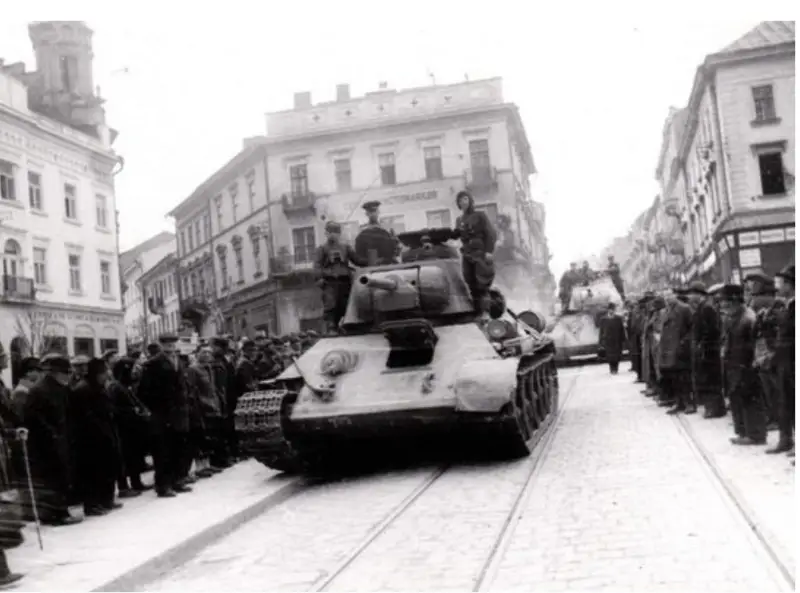
Tankers of the 64th Guards Tank Brigade of the 1st Guards Tank Army. City of Chernivtsi, March-April 1944
In addition, too large an animal (23 divisions) got into the net; such a cauldron had to be eliminated by the forces of two fronts. As a result, the encircled German formations, using gaps in the inner ring of encirclement, began to break through on March 31st. The German group was breaking through in the direction of Chortkiv and Buchach. The Germans advanced in blizzard conditions, operating at the junction of the 1st Guards and 4th Tank armies.
Zhukov tried to prevent the breakthrough of German divisions with the help of the forces of the 4th Panzer Army, the 38th Army (74th Rifle Corps), the 18th Army (52nd Rifle Corps), and separate divisions of the 1st Guards, 18th and 38th Army. However, the rifle divisions had to engage in battle after a long march, in a sprayed state, on the move, without having prepared positions. Artillery and rear units lagged behind the advanced forces.
Aviation was unable to provide adequate assistance. The spring thaw rendered unpaved airfields unusable. The combat effectiveness of the Soviet Air Force dropped significantly. Therefore, the Soviet divisions could not stop the German troops, who were desperately breaking through to their own.
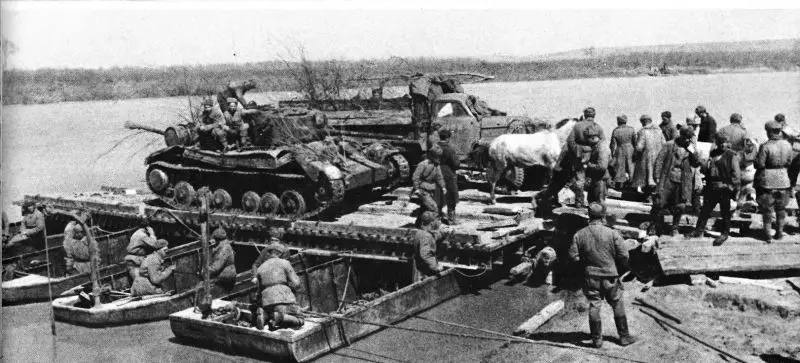
Soviet equipment on a pontoon before crossing the Prut River. On the pontoon you can see a British-made Soviet tank "Valentine" and an American-made Studebaker truck. March-April 1944
During April 1–2, heavy fighting took place. The Germans made their way, breaking the Soviet defenses. The situation was finally turned in favor of the 1st German Tank Army by the unblocking attack of the 2nd SS Panzer Corps, which arrived from France. The German command also transferred other formations from Germany, France, Denmark, Romania, Hungary and Yugoslavia to the battle area. In particular, troops of the 1st Hungarian Army were transferred to this area.
On April 4, selected SS units launched a strike towards their encircled divisions. Significant German aviation forces were also concentrated here. Having crushed the defenses of the 18th Corps and the 1st Guards Army, the 9th and 10th SS Panzer Divisions made their way to their own. After three days of fighting, the surrounded German group made its way to the Buchach area. The Wehrmacht once again showed the high class of its organization.
The German army was able to break out of the cauldron. But the 1st Tank Army suffered huge losses: the divisions lost half of their personnel, only headquarters remained from many units, and most of the heavy weapons and equipment were lost. Thus, the troops of the 1st UV captured 61 aircraft, 187 tanks and assault guns, thousands of vehicles, etc.
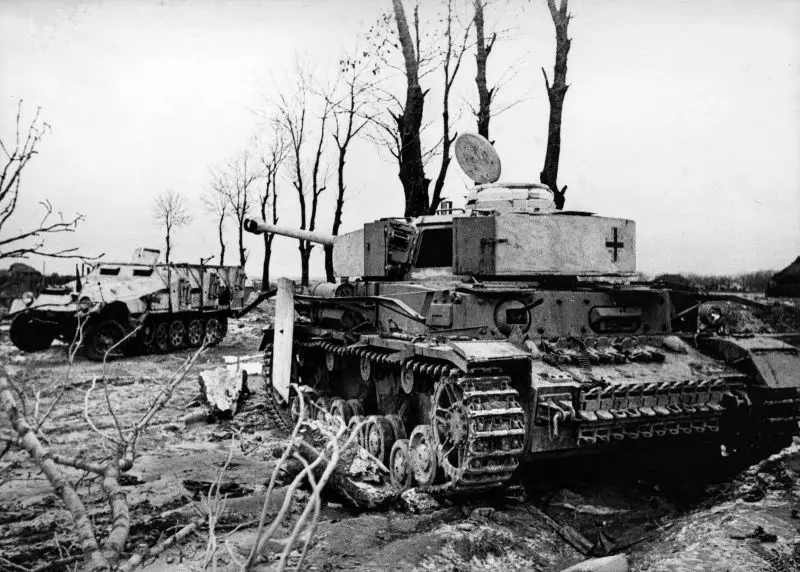
Abandoned German tank Pz. Kpfw. IV Ausf. H early series and the Wurfrahmen 40 rocket launcher (Wurfrahmen 40 installed on Sd. Kfz. 251/1 Ausf. B)
The fighting did not end there; the operation continued until April 17. Katukov's 1st Tank Army fought heavy battles on the approaches to Stanislav and in the Nadvirnaya area. The tankers had to repel strong enemy counterattacks. Only with the support of the formations of Moskalenko’s 38th Army, which the front command urgently transferred to the right bank of the Dniester, was it possible to stabilize the front. The front command also transferred the 18th Army to the right flank.
The 60th Army fought with the encircled Ternopil enemy group. The army surrounded the city on March 31, reaching the outskirts of Ternopil, but was unable to advance further. Only after repelling the external counterattacks that the Germans launched to release the encircled group, and completing preparations for the operation, was the 60th Army able to begin a decisive assault.
On April 14, Soviet troops began the assault on Ternopil. After two days of fighting, the German group was defeated, and on April 17 its remnants were eliminated. According to German data, only a few dozen people were saved. On the same day, the troops of the 1st UV went on the defensive.
The operation was completed successfully.
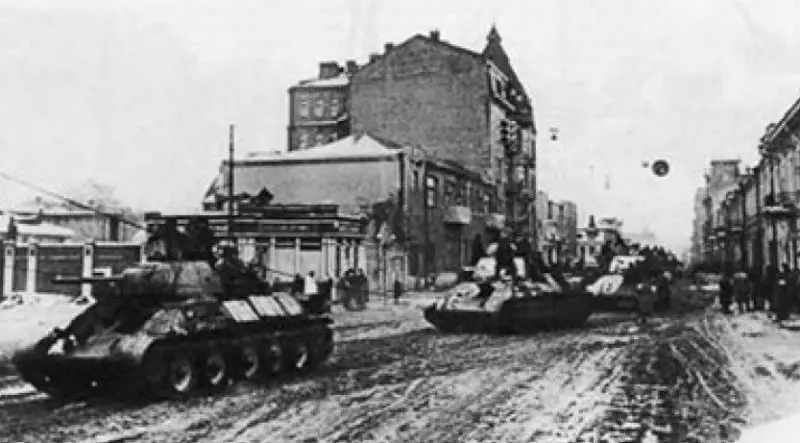
Soviet tank crews, the city of Proskurov, March-April 1944.
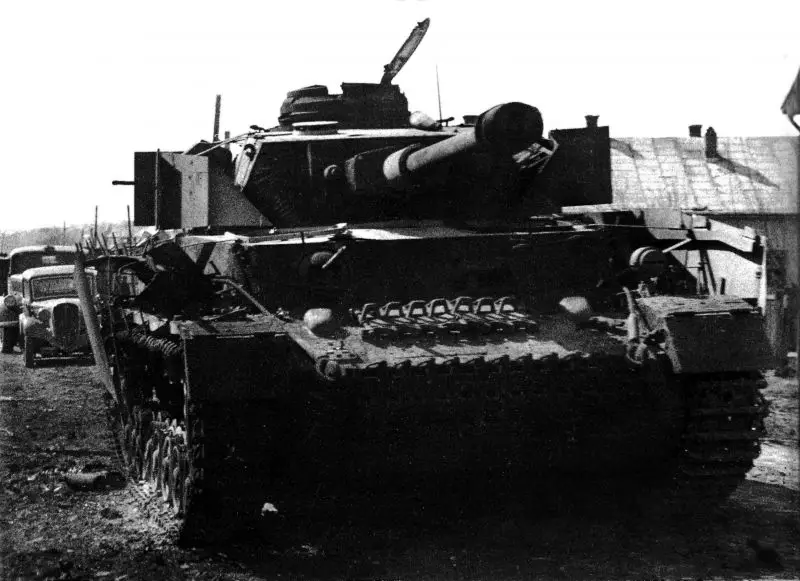
German tank Pz. Kpfw. IV Ausf. H, knocked out by Soviet troops in the city of Chernivtsi (after 1944 - Chernivtsi). The city was liberated on March 29, 1944 by units of the 1st Ukrainian Front during the Proskurov-Chernovtsy operation. The tank is equipped with mounted anti-cumulative screens; traces of a fire are visible on the right side of the tank. April 1944
Results
Zhukov's armies advanced 80–350 kilometers, reaching the line of Torchin, Brody, Buchach, Stanislav, Nadvirnaya. The Red Army reached the foothills of the Carpathians, the borders of Czechoslovakia and Romania.
Soviet troops liberated a significant part of Right Bank Ukraine - the Kamenets-Podolsk region, most of the Vinnytsia, Ternopil and Chernivtsi regions, several districts of the Rivne and Ivano-Frankivsk regions (about 42 thousand sq. km). 57 cities were liberated from the Nazis, including three regional centers - Vinnitsa, Ternopil and Chernivtsi, several large railway junctions, a large number of towns, villages and hamlets.
1-I and 4-I German armies suffered heavy losses. 22 German divisions, several tank and motorized brigades, other individual units lost more than half of their personnel and most of the heavy weapons, the equipment, in fact, temporarily lost its combat effectiveness. According to Soviet data, in the period from March 4 to March 31, 1944 alone, more than 183 thousand German soldiers were killed, and about 25 thousand more were captured. To close the gap, the German command had to transfer, in addition to those divisions that were brought forward from reserve during the battle, up to ten divisions, including two tank divisions and a number of separate formations. Reserves were transferred from Western Europe. The 1st Hungarian Army was advanced to the foothills of the Carpathians.
Soviet troops reached the Carpathians, the state border of the USSR, and fulfilled the main goal of the operation - they cut the enemy’s strategic front into two parts, south and north of the Carpathians. The enemy's main communications lines were cut off. The conditions were created for the defeat of the entire southern flank of German troops, which followed in the summer of 1944.
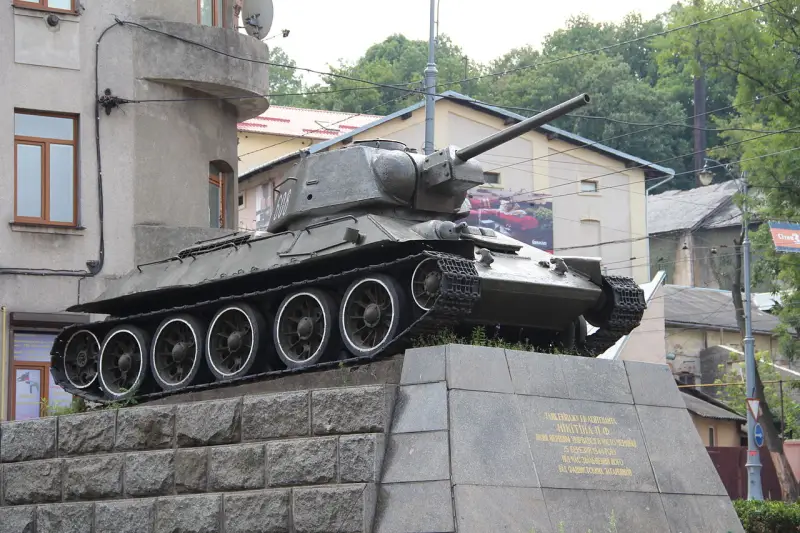
At the request of the workers of the railway junction and knitting factory of the city of Chernivtsi, the Military Council of the 1st Guards Tank Army, in memory of the liberation of the city, left there a T-34 tank crewed by the guard of Lieutenant Pavel Fedorovich Nikitin, who was the first to break into Chernivtsi on March 25, 1944[17]. In 1946, the tank was installed on a pedestal on Gagarin Street.
However, the 1st UV was unable to implement the task of eliminating the 1st Tank Army. There was not enough strength for this. The units that went out to the external and internal fronts of the encirclement lost many people and equipment in the previous fierce battles. Due to the spring thaw, the artillery and rear forces lagged behind. There were not enough tanks to fight German tank formations (the tanks were knocked out in the first part of the operation, during the breach of the enemy’s defenses). And due to problems with runways, unpaved airfields could not operate at full capacity, and aviation was not able to fully support the ground forces. In addition, the German command constantly increased the number of fighting divisions.
A special feature of the operation was the use of large tank groups by both sides. During the second stage of the offensive of the 21st UV, which began on March 1, three tank armies and two separate tank corps were thrown into battle at once. From the very beginning of the battle, the Germans had 10 tank and one motorized divisions. This gave the battle a special intensity, speed and maneuverability.
Overall, the operation was successful and showed the increased skill of Soviet commanders and soldiers. The morale of the Soviet troops was very high, the soldiers were eager to liberate their native land from the enemy. It is not for nothing that 70 formations and units that distinguished themselves in battle were given honorary names - Proskurov, Vinnitsa, Yampol, Chernivtsi, etc.
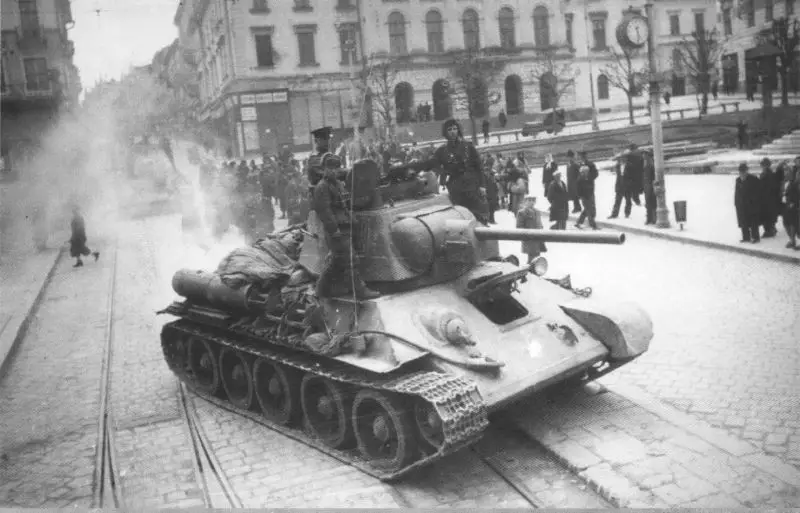
A column of Soviet T-34 tanks moves along the street of liberated Chernivtsi. 1st Ukrainian Front. March 30, 1944
Information